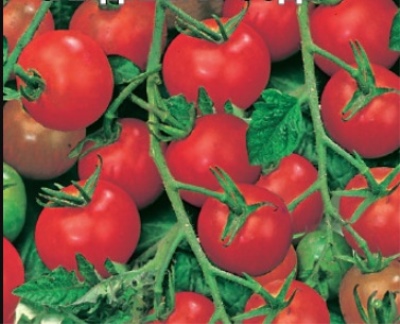
- Authors: Lukyanenko A.N., Dubinin S.V., Dubinina I.N.
- Year of approval: 2009
- Category: grade
- Growth type: indeterminate
- Appointment: fresh consumption, for whole-fruit preservation, for juice
- Ripening period: early
- Ripening time, days: 90-100
- Growing conditions: for open ground, for film greenhouses
- Bush height, cm: more than 250
- Leaves: large, dark green
Lovers of dessert tomatoes, as well as cherry tomatoes, will certainly like the early variety Sweet Bunch and will become one of their favorites, since it is easy to grow, gives tasty fruits and abundant yields.
Breeding history
Early culture Sweet bunch was bred by domestic breeders Dubinin, Lukyanenko and Dubinina in 2008. The certificate of inclusion in the selection register of the achievements of the Russian Federation was obtained in 2009. Recommended for cultivation in all climatic zones of the country. The maximum productivity is achieved when growing tomatoes in film greenhouses, however, in the southern regions, the culture grows well in open ground.
Description of the variety
Vegetable culture The sweet bunch is a tall plant of an indeterminate type. Tomato bushes prone to weaving grow up to 250 cm. The plant is characterized by moderate thickening with dark green leaves, a strong central stem and flexible branches, a developed root system, and a simple structure of inflorescences. In the first 2-3 fruit clusters, the largest number of berries is formed - 40-50 units in each, and all subsequent ones - from 20 or more.
During the cultivation of the culture, it is necessary to form bushes in 1-2 stems, regularly remove new stepchildren, and also be sure to tie the plants to supports (it is better to use twine and bamboo sticks). The dessert variety has a universal purpose - it is used in cooking, eaten fresh, canned, pickled, frozen. Mini tomatoes are ideal for whole fruit canning.
The main qualities of the fruit
Early tomato The sweet cluster is characterized by an attractive presentation. The variety represents the class of small-fruited nightshades. On average, the mass of one tomato is 20-30 grams, but sometimes they grow up to 50-60 g. Berries of different sizes can grow in one fruit cluster. The shape of the tomato is round, without any irregularities. When ripe, the tomato is evenly covered with a bright red color, and when ripe, it is green without a dark spot at the base. The skin of the vegetable is perfectly smooth, shiny and dense enough, so that the tomato is resistant to cracking. In addition, the fruits are transportable and store well in a cool place.
Taste characteristics
The palatability of the fruit is good. The pulp is fleshy, medium-dense, juicy, with a small number of small seeds. The taste of tomatoes, despite the name, is sweet and sour with a pronounced spicy aroma. When eaten fresh, the hardness of the skin is felt, which protects the fruits from deformation during heat treatment.
Ripening and fruiting
Early cherry tomatoes. From mass seedlings to ripe tomatoes on the branches, 90-100 days pass. The variety is characterized by abundant fruiting, the intensity of which is stretched, so there is an opportunity to enjoy delicious tomatoes until autumn. Although experienced farmers recommend removing the fruits with whole brushes.
Yield
The yield indicators of the variety are good. With minimal agricultural technology, at least 3.5 kg of ripe tomatoes can be harvested per 1 m2 per season.
The timing of planting seedlings and planting in the ground
Sowing seeds is best done between late February and mid-March (50-60 days before transplanting to the greenhouse). It is better to plant seedlings in garden soil (it is not recommended to buy peat soil). Seedling germination occurs on the 5-7th day under the correct growing conditions (lighting for more than 12 hours / day and a temperature of 22-25 degrees). The dive is carried out at the stage of the appearance of several leaves on the bush.
It is recommended to transplant plants into a greenhouse on a cloudy day. The best period is the end of April - end of May.

Growing tomato seedlings is an extremely important process, because it largely depends on whether the gardener will be able to harvest at all. All aspects must be taken into account, from seedbed preparation to planting in the ground.
Landing scheme
When planting seedlings, it is imperative to observe the density and planting pattern, which will provide the plants with a comfortable growth. No more than 3 bushes should grow per 1 m2. The recommended scheme for planting is 60x40 cm.

Growing and care
The most suitable for growing this culture is the seedling method. The soil is cleaned, disinfected, moistened, loosened so that it breathes well. It is not recommended to plant tomatoes in the place where potatoes or eggplants used to grow. Comprehensive tomato care consists of a number of activities: moderate watering, fertilizing, weeding, loosening and mulching the soil, forming bushes, tying to supports, pinching, ventilating the greenhouse and protecting against viruses and insects.




A plant needs different micronutrients at each stage of growth. All fertilizers can be divided into two groups: mineral and organic. Folk remedies are often used: iodine, yeast, bird droppings, eggshells.
It is important to observe the rate and period of feeding. This also applies to folk remedies and organic fertilizers.
Disease and pest resistance
The variety is resistant to major tomato diseases, but tends to be affected by late blight, which can be caused by drafts and excessive humidity in the greenhouse.


Resistant to adverse weather conditions
The culture has a high resistance to stress. It is resistant to weather fluctuations, short-term drought and heat. Tomato does not like excess moisture and drafts. In addition, even the slightest frost (–1 ... 2 degrees) may adversely affect the yield.

























































































